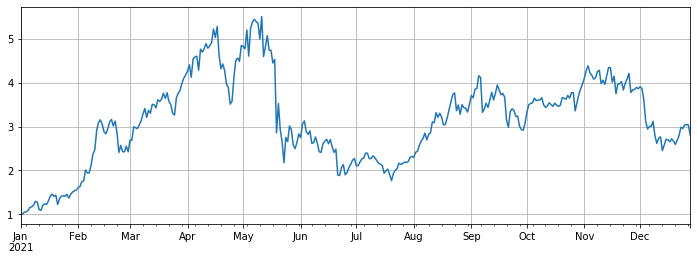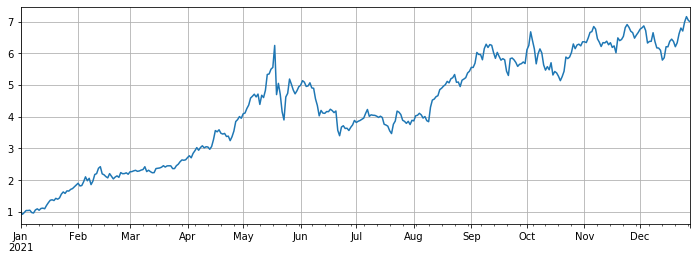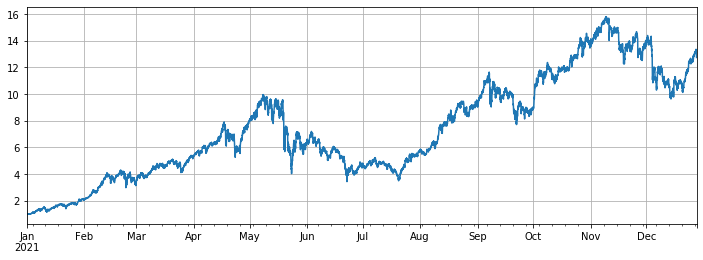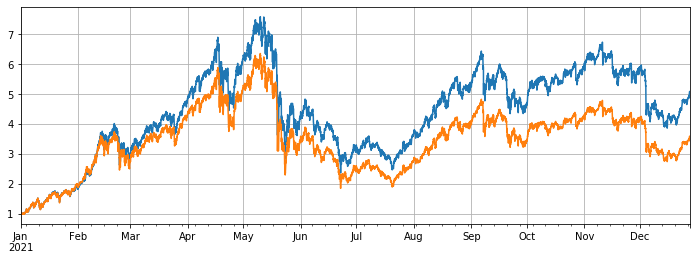Xem xét thị trường tiền kỹ thuật số năm 2021 và chiến lược đơn giản nhất 10 lần bỏ lỡ
Tác giả:FMZ~Lydia, Tạo: 2022-10-26 16:12:49, Cập nhật: 2023-09-15 20:41:17
Tóm tắt cho năm 2021 và các chiến lược trong tương lai
Năm 2021 sắp kết thúc, và các điểm nóng từ DEFI đến GAMEFI đang nổi lên trong một dòng chảy vô tận, và thị trường nói chung vẫn là thị trường tăng trưởng. Bây giờ nhìn lại và tóm tắt, bạn đã đạt được bao nhiêu trong năm 2021? Bạn đã bỏ lỡ cơ hội nào? Một số khoản đầu tư thành công là gì? Gần đây, tôi đã xem xét thị trường lịch sử của năm qua và tìm thấy một chiến lược lợi nhuận đơn giản bất ngờ, đó là chỉ số đa tiền tệ.
Có rất nhiều loại tiền tệ trên sàn giao dịch, nhiều trong số đó được định mệnh là không được biết đến và thậm chí có thể bị rút khỏi giao dịch. Ở đây chúng tôi chọn loại tiền tệ của Binance vĩnh viễn đã được sử dụng trên thị trường. Chúng thường được kiểm tra và công nhận là các loại tiền tệ chính thống, tương đối an toàn. Sau khi sàng lọc đơn giản, một số loại tiền tệ chỉ số đã được loại bỏ và 134 loại tiền tệ cuối cùng đã được thu được.
Trong [1]:
import requests
from datetime import date,datetime
import time
import pandas as pd
import numpy as np
import matplotlib.pyplot as plt
%matplotlib inline
Trong [144]:
## Current trading pairs
Info = requests.get('https://fapi.binance.com/fapi/v1/exchangeInfo')
symbols = [s['symbol'] for s in Info.json()['symbols']]
Trong [154]:
symbols_f = list(set(filter(lambda x: x[-4:] == 'USDT', [s.split('_')[0] for s in symbols]))-
set(['1000SHIBUSDT','1000XECUSDT','BTCDOMUSDT','DEFIUSDT','BTCSTUSDT'])) + ['SHIBUSDT','XECUSDT']
print(symbols_f)
Trong [155]:
print(len(symbols_f))
Thị trường trong năm qua
Sau đó, chúng ta có được giá đóng cửa hàng ngày của họ trong năm qua, lưu ý rằng một số loại tiền tệ đã được trên kệ trong một khoảng thời gian ngắn, vì vậy chúng ta cần phải điền vào dữ liệu.
Trong khi đó, SOL, FTM, LUNA, MATIC, SAND và AXS đã tăng gần 100 lần. Trong số đó, AXS tăng 168 lần, làm cho nó trở thành con ngựa đen lớn nhất. Mức trung bình tăng 3 lần, chủ yếu là do chuỗi công cộng và trò chơi. Để loại bỏ sự thiên vị tồn tại, chúng tôi loại trừ đồng tiền mới vĩnh viễn trong giai đoạn này và chúng tôi cũng đạt được gần 11 lần lợi nhuận. Đó là 7 lần lợi nhuận cho BTC.
Đây là một tỷ lệ lợi nhuận tuyệt vọng. Tôi đã làm việc chăm chỉ để thực hiện tất cả các loại chiến lược, nhưng nó là xa so với lợi nhuận của việc không làm gì trong một năm. Tuy nhiên, cần lưu ý rằng một số tăng cụ thể là quá lớn và nó đã lệch khỏi chỉ số rõ ràng. Nếu các loại tiền tệ này không được chọn vào đầu năm, lợi nhuận sẽ gần trung bình, mà là ít có lợi nhuận hơn nhiều.
Trong [157]:
#Obtain the function of K-line in any period
def GetKlines(symbol='BTCUSDT',start='2020-8-10',end='2021-8-10',period='1h',base='fapi',v = 'v1'):
Klines = []
start_time = int(time.mktime(datetime.strptime(start, "%Y-%m-%d").timetuple()))*1000 + 8*60*60*1000
end_time = int(time.mktime(datetime.strptime(end, "%Y-%m-%d").timetuple()))*1000 + 8*60*60*1000
intervel_map = {'m':60*1000,'h':60*60*1000,'d':24*60*60*1000}
while start_time < end_time:
mid_time = min(start_time+1000*int(period[:-1])*intervel_map[period[-1]],end_time)
url = 'https://'+base+'.binance.com/'+base+'/'+v+'/klines?symbol=%s&interval=%s&startTime=%s&endTime=%s&limit=1000'%(symbol,period,start_time,mid_time)
res = requests.get(url)
res_list = res.json()
if type(res_list) == list and len(res_list) > 0:
start_time = res_list[-1][0]
Klines += res_list
elif type(res_list) == list:
start_time = start_time+1000*int(period[:-1])*intervel_map[period[-1]]
else:
break
df = pd.DataFrame(Klines,columns=['time','open','high','low','close','amount','end_time','volume','count','buy_amount','buy_volume','null']).astype('float')
df.index = pd.to_datetime(df.time,unit='ms')
return df
Trong [164]:
df_all_s = pd.DataFrame(index=pd.date_range(start='2021-1-1', end='2021-12-28', freq='1d'),columns=symbols_s)
for i in range(len(symbols_f)):
#print(symbols_s[i])
symbol_s = symbols_f[i]
df_s = GetKlines(symbol=symbol_s,start='2021-1-1',end='2021-12-28',period='1d',base='api',v='v3')
df_all_s[symbol_s] = df_s[~df_s.index.duplicated(keep='first')].close
Trong [165]:
df_all_s.tail() #data structure
Ra khỏi [1]:
Trong [174]:
df_all = df_all_s.fillna(method='bfill')#filled data
df_norm = df_all/df_all.iloc[0] #normalization
df_norm.mean(axis=1).plot(figsize=(12,4),grid=True);
#The final index return chart
Ra khỏi [1]:

Trong [175]:
#The median increase
df_norm.median(axis=1).plot(figsize=(12,4),grid=True);
Ra khỏi [1]:

Trong [168]:
#Ranking for increase/decrease
print(df_norm.iloc[-1].round(2).sort_values().to_dict())
Trong [317]:
#Maximum rollback of current price compared with the highest point in the year
print((1-df_norm.iloc[-1]/df_norm.max()).round(2).sort_values().to_dict())
Trong [177]:
df_all_f = pd.DataFrame(index=pd.date_range(start='2021-1-1', end='2021-12-28', freq='1d'),columns=symbols_s)
for i in range(len(symbols_f)):
#print(symbols_s[i])
symbol_f = symbols_f[i]
df_f = GetKlines(symbol=symbol_f,start='2021-1-1',end='2021-12-28',period='1d',base='fapi',v='v1')
df_all_f[symbol_f] = df_f[~df_f.index.duplicated(keep='first')].close
Trong [208]:
#Excluding new currency
df = df_all_s[df_all_s.columns[~df_all_f.iloc[0].isnull()]]
df = df.fillna(method='bfill')
df = df/df.iloc[0]
df.mean(axis=1).plot(figsize=(12,4),grid=True);
Ra khỏi[208]:

Trong [212]:
#Compared with Bitcoin
(df.mean(axis=1)/df.BTCUSDT).plot(figsize=(12,4),grid=True);
Ra khỏi [1]:

Trong [213]:
#Use the original backtest engine
class Exchange:
def __init__(self, trade_symbols, fee=0.0004, initial_balance=10000):
self.initial_balance = initial_balance #Initial assets
self.fee = fee
self.trade_symbols = trade_symbols
self.account = {'USDT':{'realised_profit':0, 'unrealised_profit':0, 'total':initial_balance, 'fee':0}}
for symbol in trade_symbols:
self.account[symbol] = {'amount':0, 'hold_price':0, 'value':0, 'price':0, 'realised_profit':0,'unrealised_profit':0,'fee':0}
def Trade(self, symbol, direction, price, amount):
cover_amount = 0 if direction*self.account[symbol]['amount'] >=0 else min(abs(self.account[symbol]['amount']), amount)
open_amount = amount - cover_amount
self.account['USDT']['realised_profit'] -= price*amount*self.fee #Deduct the handling fee
self.account['USDT']['fee'] += price*amount*self.fee
self.account[symbol]['fee'] += price*amount*self.fee
if cover_amount > 0: #Close the position first
self.account['USDT']['realised_profit'] += -direction*(price - self.account[symbol]['hold_price'])*cover_amount #Profits
self.account[symbol]['realised_profit'] += -direction*(price - self.account[symbol]['hold_price'])*cover_amount
self.account[symbol]['amount'] -= -direction*cover_amount
self.account[symbol]['hold_price'] = 0 if self.account[symbol]['amount'] == 0 else self.account[symbol]['hold_price']
if open_amount > 0:
total_cost = self.account[symbol]['hold_price']*direction*self.account[symbol]['amount'] + price*open_amount
total_amount = direction*self.account[symbol]['amount']+open_amount
self.account[symbol]['hold_price'] = total_cost/total_amount
self.account[symbol]['amount'] += direction*open_amount
def Buy(self, symbol, price, amount):
self.Trade(symbol, 1, price, amount)
def Sell(self, symbol, price, amount):
self.Trade(symbol, -1, price, amount)
def Update(self, close_price): #Update the assets
self.account['USDT']['unrealised_profit'] = 0
for symbol in self.trade_symbols:
self.account[symbol]['unrealised_profit'] = (close_price[symbol] - self.account[symbol]['hold_price'])*self.account[symbol]['amount']
self.account[symbol]['price'] = close_price[symbol]
self.account[symbol]['value'] = abs(self.account[symbol]['amount'])*close_price[symbol]
self.account['USDT']['unrealised_profit'] += self.account[symbol]['unrealised_profit']
self.account['USDT']['total'] = round(self.account['USDT']['realised_profit'] + self.initial_balance + self.account['USDT']['unrealised_profit'],6)
Trong [418]:
#The hourly K-line was taken to make the backtest more accurate
df_all_s = pd.DataFrame(index=pd.date_range(start='2021-1-1', end='2021-12-28', freq='1h'),columns=symbols_s)
for i in range(len(symbols_f)):
#print(symbols_s[i])
symbol_s = symbols_f[i]
df_s = GetKlines(symbol=symbol_s,start='2021-1-1',end='2021-12-28',period='1h',base='api',v='v3')
df_all_s[symbol_s] = df_s[~df_s.index.duplicated(keep='first')].close
Trong [419]:
df = df_all_s[df_all_s.columns[~df_all_f.iloc[0].isnull()]]
df = df.fillna(method='bfill')
df = df/df.iloc[0]
df.mean(axis=1).plot(figsize=(12,4),grid=True);
Ra khỏi [419]:

Hiệu suất của các chiến lược cân bằng
Trong thử nghiệm ngược, tất cả các loại tiền tệ của hợp đồng vĩnh cửu trực tuyến Binance vào ngày 1 tháng 1 năm 2021 đã được chọn. Thời gian K-line là 1h. Các thông số bắt đầu mở rộng quy mô trong các vị trí khi vị trí thấp hơn 5% so với mức trung bình, và bán chúng khi vị trí cao hơn 5%. Khi thử nghiệm ngược là tất cả các loại tiền tệ, lợi nhuận chiến lược cuối cùng là 7,7 lần. Rõ ràng không tốt như lợi nhuận trung bình 13 lần. Điều này cũng được mong đợi. Sau tất cả, một số loại tiền tệ tăng một trăm lần là quá đặc biệt, và chiến lược cân bằng sẽ bán tất cả chúng.
Nếu loại bỏ 10 loại tiền tệ tăng cao nhất khỏi backtest, chỉ có các loại tiền tệ tương đối tầm thường sẽ được xem xét, và thu nhập cuối cùng sẽ là 4,8 lần, vượt xa so với hiệu suất trung bình 3,4 lần.
Nếu chỉ có 3 đồng tiền tăng cao nhất được xoay, lợi nhuận cuối cùng sẽ là 373 lần, cao hơn nhiều so với hiệu suất trung bình 160 lần. Điều này cho thấy rằng nếu xu hướng và tăng của đồng tiền xoay được chọn có xu hướng nhất quán, kết quả xoay sẽ tốt hơn nhiều so với không làm gì cả.
Trong [494]:
#Full currency backtest
symbols = list(df.iloc[-1].sort_values()[:].index)
e = Exchange(symbols, fee=0.001, initial_balance=10000)
res_list = []
avg_pct = 1/len(symbols)
for row in df[symbols].iterrows():
prices = row[1]
total = e.account['USDT']['total']
e.Update(prices)
for symbol in symbols:
pct = e.account[symbol]['value']/total
if pct < 0.95*avg_pct:
e.Buy(symbol,prices[symbol],(avg_pct-pct)*total/prices[symbol])
if pct > 1.05*avg_pct:
e.Sell(symbol,prices[symbol],(pct-avg_pct)*total/prices[symbol])
res_list.append([e.account[symbol]['value'] for symbol in symbols] + [e.account['USDT']['total']])
res = pd.DataFrame(data=res_list, columns=symbols+['total'],index = df.index)
Trong [495]:
e.account['USDT']
Ngoài[495]:
Trong [496]:
# Backtest performance of full currencies
(res.total/10000).plot(figsize=(12,4),grid = True);
df[symbols].mean(axis=1).plot(figsize=(12,4),grid=True);
Ra khỏi[496]:

Trong [498]:
#Remove currencies with huge growth
symbols = list(df.iloc[-1].sort_values()[:-10].index)
e = Exchange(symbols, fee=0.001, initial_balance=10000)
res_list = []
avg_pct = 1/len(symbols)
for row in df[symbols].iterrows():
prices = row[1]
total = e.account['USDT']['total']
e.Update(prices)
for symbol in symbols:
pct = e.account[symbol]['value']/total
if pct < 0.95*avg_pct:
e.Buy(symbol,prices[symbol],(avg_pct-pct)*total/prices[symbol])
if pct > 1.05*avg_pct:
e.Sell(symbol,prices[symbol],(pct-avg_pct)*total/prices[symbol])
res_list.append([e.account[symbol]['value'] for symbol in symbols] + [e.account['USDT']['total']])
res = pd.DataFrame(data=res_list, columns=symbols+['total'],index = df.index)
Trong [501]:
e.account['USDT']
Ra khỏi[501]:
Trong [499]:
(res.total/10000).plot(figsize=(12,4),grid = True);
df[symbols].mean(axis=1).plot(figsize=(12,4),grid=True);
Ra khỏi [499]:

Trong [503]:
#Only the currency with the highest increase is tested
symbols = list(df.iloc[-1].sort_values()[-3:].index)
e = Exchange(symbols, fee=0.001, initial_balance=10000)
res_list = []
avg_pct = 1/len(symbols)
for row in df[symbols].iterrows():
prices = row[1]
total = e.account['USDT']['total']
e.Update(prices)
for symbol in symbols:
pct = e.account[symbol]['value']/total
if pct < 0.95*avg_pct:
e.Buy(symbol,prices[symbol],(avg_pct-pct)*total/prices[symbol])
if pct > 1.05*avg_pct:
e.Sell(symbol,prices[symbol],(pct-avg_pct)*total/prices[symbol])
res_list.append([e.account[symbol]['value'] for symbol in symbols] + [e.account['USDT']['total']])
res = pd.DataFrame(data=res_list, columns=symbols+['total'],index = df.index)
Trong [504]:
e.account['USDT']
Ra khỏi[504]:
Trong [505]:
(res.total/10000).plot(figsize=(12,4),grid = True);
df[symbols].mean(axis=1).plot(figsize=(12,4),grid=True);
Ngoài[505]:

Tóm lại
Nói chung, năm 2021 sẽ là một thị trường tăng giá cho các đồng tiền giả và một năm giảm giá cho Bitcoin. Giá trị thị trường của Bitcoin đã giảm xuống còn 40% hiện nay từ 70% vào đầu năm, đây là mức thấp nhất trong lịch sử. Do đó, lợi nhuận trung bình từ việc mua và giữ hàng giả trong năm qua cao hơn nhiều so với việc giữ Bitcoin. Nhìn về phía trước vào năm 2022, nếu bạn cho rằng vẫn sẽ có nhiều loại tiền tệ hàng trăm lần trong thị trường hiện tại trong tương lai, bạn có thể đa dạng hóa các vị trí của mình một cách táo bạo và kiên nhẫn chờ đợi. Nếu bạn đặc biệt lạc quan về một vài loại tiền tệ hoặc thị trường trung bình, bạn có thể sử dụng chiến lược xoay để có lợi nhuận dư thừa mà không suy nghĩ. Nếu bạn nghĩ rằng mọi thứ sẽ đạt đến nhau khi chúng trở nên cực đoan, bạn có thể mặc cả săn Bitcoin để có được lợi nhuận và an ninh tốt hơn.
- Thực hành định lượng của DEX Exchange (2) -- Hướng dẫn người dùng Hyperliquid
- DEX giao dịch định lượng thực hành ((2) -- Hyperliquid sử dụng hướng dẫn
- Thực hành định lượng của DEX Exchange (1) -- dYdX v4 User Guide
- Giới thiệu về trọng tài lead-lag trong tiền điện tử (3)
- DEX giao dịch định lượng thực hành ((1) -- dYdX v4 hướng dẫn sử dụng
- Giới thiệu về bộ phận Lead-Lag trong tiền kỹ thuật số (3)
- Giới thiệu về Trọng tài Lead-Lag trong Cryptocurrency (2)
- Giới thiệu về bộ phận Lead-Lag trong tiền kỹ thuật số (2)
- Thảo luận về tiếp nhận tín hiệu bên ngoài của nền tảng FMZ: Một giải pháp hoàn chỉnh để tiếp nhận tín hiệu với dịch vụ Http tích hợp trong chiến lược
- Phân tích nhận tín hiệu bên ngoài nền tảng FMZ: Chiến lược xây dựng dịch vụ HTTP để nhận tín hiệu
- Giới thiệu về Trọng tài Lead-Lag trong Cryptocurrency (1)
- Viết một công cụ giao dịch bán tự động bằng cách sử dụng ngôn ngữ Pine
- Khám phá thiết kế chiến lược tần số cao từ sự thay đổi ma thuật của LeeksReaper
- Phân tích chiến lược của LeeksReaper (2)
- "Chiến lược EMA hai lần ma thuật" từ các cựu chiến binh YouTube
- Thực hiện ngôn ngữ JavaScript của các chỉ số Fisher và vẽ trên FMZ
- Ví dụ về thiết kế chiến lược dYdX
- Thiết kế hệ thống quản lý đồng bộ hóa đơn hàng dựa trên FMZ Quant (1)
- Phân tích chiến lược của LeeksReaper (1)
- Định nghĩa của các khoản đầu tư khác
- Tình trạng gần đây và hoạt động khuyến nghị của chiến lược tỷ lệ tài trợ
- Mô hình yếu tố tiền tệ kỹ thuật số
- Từ YouTube: "Chiến lược đường thẳng EMA đôi kỳ diệu"
- Viết một công cụ giao dịch bán tự động bằng ngôn ngữ Pine
- Mô hình nhân tố tiền kỹ thuật số
- Hãy là người cứu rỗi của chính mình trong giao dịch.
- Chiến lược phòng ngừa rủi ro của hợp đồng tương lai và điểm tiền điện tử thủ công
- Thiết kế chiến lược phòng ngừa rủi ro giao ngay tiền điện tử ((1)
- Một chiến lược cân bằng vĩnh cửu phù hợp với thị trường gấu đáy
- Giao dịch số lượng tiền điện tử cho người mới bắt đầu - đưa bạn đến gần số lượng tiền điện tử (8)
- Giao dịch số lượng tiền điện tử cho người mới bắt đầu - đưa bạn đến gần số lượng tiền điện tử (7)